5 Steps to a 5: AP Calculus AB 2017 (2016)
STEP 4
Review the Knowledge You Need to Score High
CHAPTER 10
Big Idea 2: Derivatives
More Applications of Derivatives
IN THIS CHAPTER
Summary : Finding an equation of a tangent is one of the most common questions on the AP Calculus AB exam. In this chapter, you will learn how to use derivatives to find an equation of a tangent, and to use the tangent line to approximate the value of a function at a specific point. You will also learn to apply derivatives to solve rectilinear motion problems.

Key Ideas
![]() Tangent and Normal Lines
Tangent and Normal Lines
![]() Linear Approximations
Linear Approximations
![]() Motion Along a Line
Motion Along a Line
10.1 Tangent and Normal Lines
Main Concepts: Tangent Lines, Normal Lines
Tangent Lines
If the function y is differentiable at x = a , then the slope of the tangent line to the graph of y at x = a is given as 
Types of Tangent Lines
Horizontal Tangents: 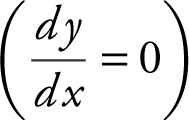 . (See Figure 10.1-1 .)
. (See Figure 10.1-1 .)
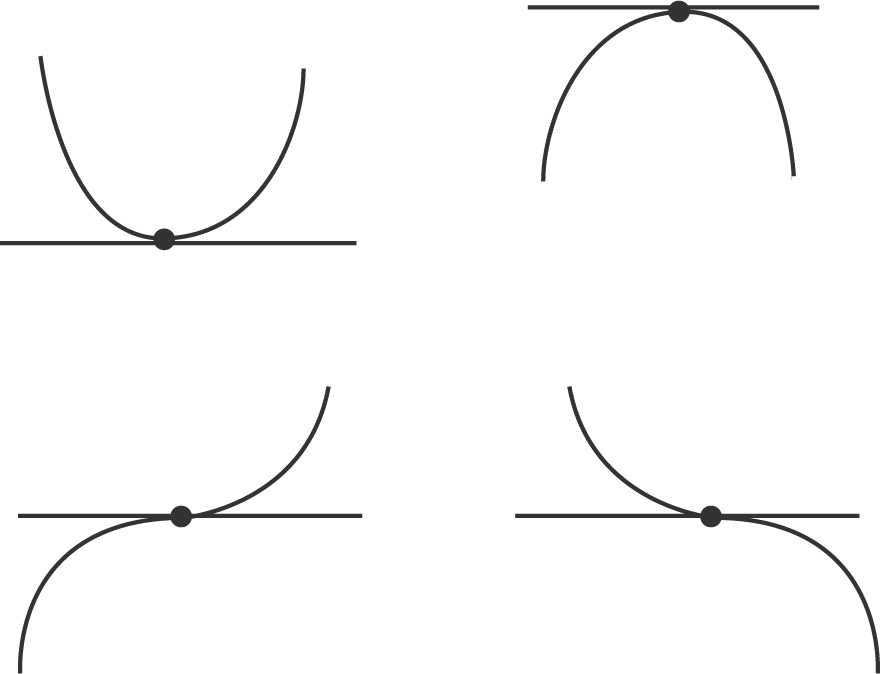
Figure 10.1-1
Vertical Tangents: ( does not exist but
does not exist but  = 0). (See Figure 10.1-2 .)
= 0). (See Figure 10.1-2 .)
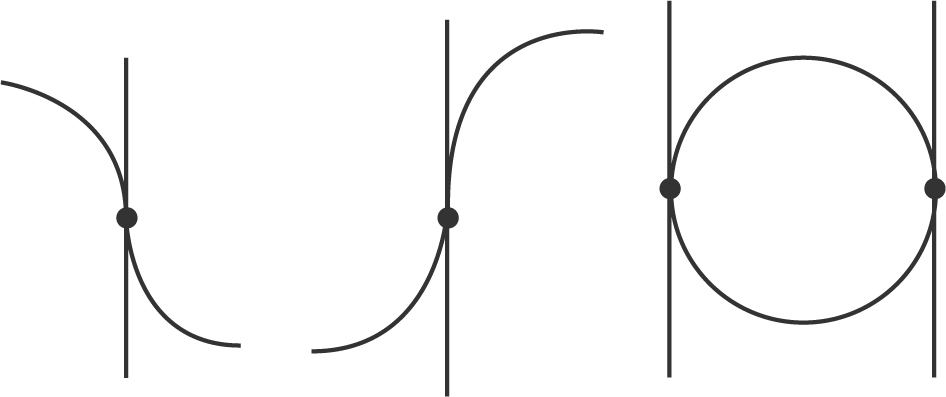
Figure 10.1-2
Parallel Tangents: 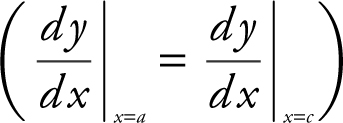 . (See Figure 10.1-3 .)
. (See Figure 10.1-3 .)
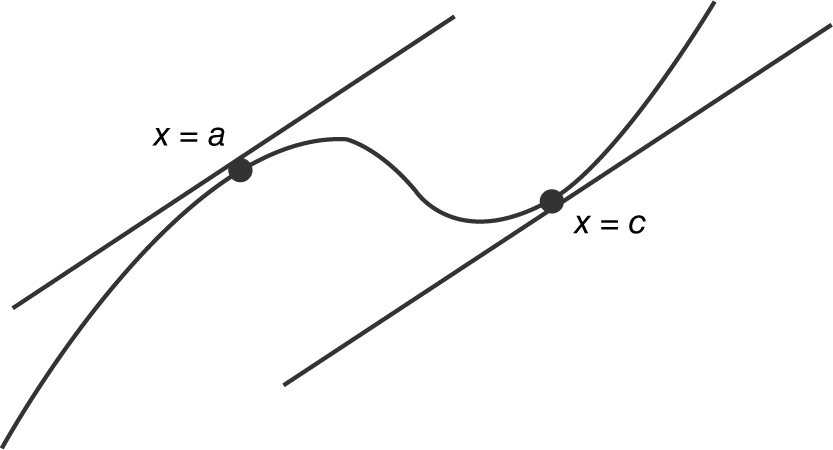
Figure 10.1-3
Example 1
Write an equation of the line tangent to the graph of y = –3 sin 2x at  . (See Figure 10.1-4 .)
. (See Figure 10.1-4 .)
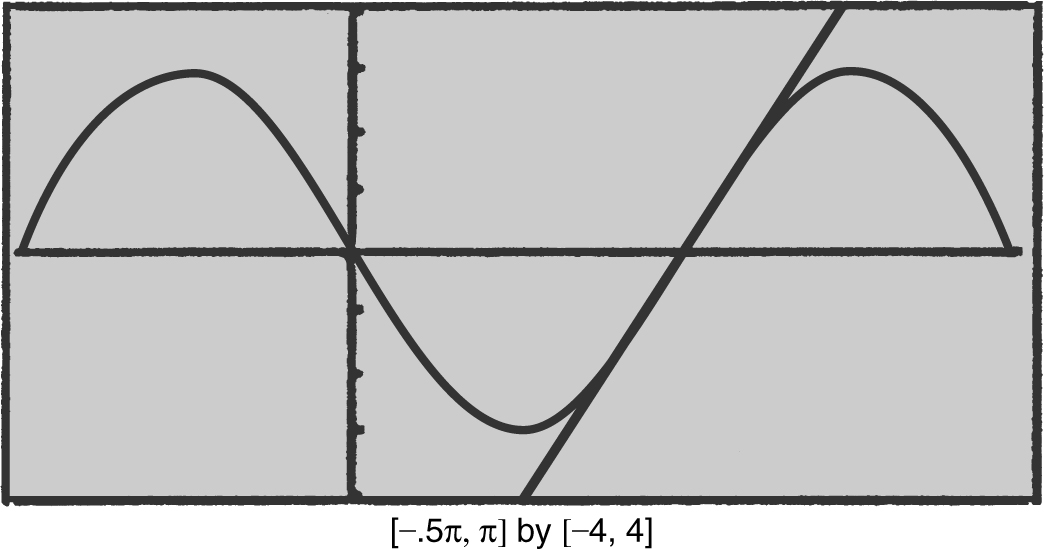
Figure 10.1-4
y = –3 sin 2x ; 
Slope of tangent  .
.
Point of tangency: 
Therefore,  is the point of tangency.
is the point of tangency.
Equation of tangent: y – 0 = 6(x – π /2) or y = 6x – 3π .
Example 2
If the line y = 6x + a is tangent to the graph of y = 2x 3 , find the value(s) of a .
Solution:
 (See Figure 10.1-5 .)
(See Figure 10.1-5 .)
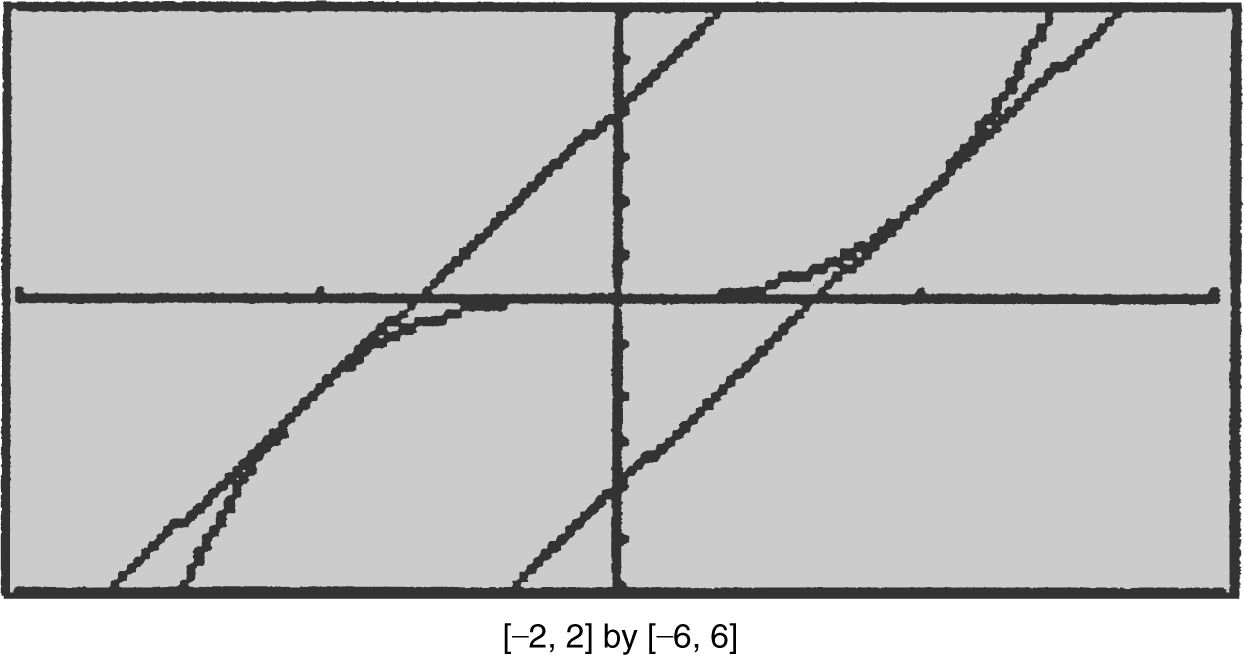
Figure 10.1-5
The slope of the line y = 6x + a is 6.
Since y = 6x + a is tangent to the graph of y = 2x 3 , thus 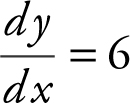 for some values of x .
for some values of x .
Set 6x 2 = 6 ⇒ x 2 = 1 or x = ±1.
At x = –1, y = 2x 3 = 2(–1)3 = –2;(–1, –2) is a tangent point. Thus, y = 6x + a ⇒ –2 = 6(–1) + a or a = 4.
At x = 1, y = 2x 3 = 2(1)3 = 2; (1, 2) is a tangent point.
Thus, y = 6x + a ⇒ 2 = 6(1) + a or a = –4.
Therefore, a = ±4.
Example 3
Find the coordinates of each point on the graph of y 2 – x 2 – 6x + 7 = 0 at which the tangent line is vertical. Write an equation of each vertical tangent. (See Figure 10.1-6 .)
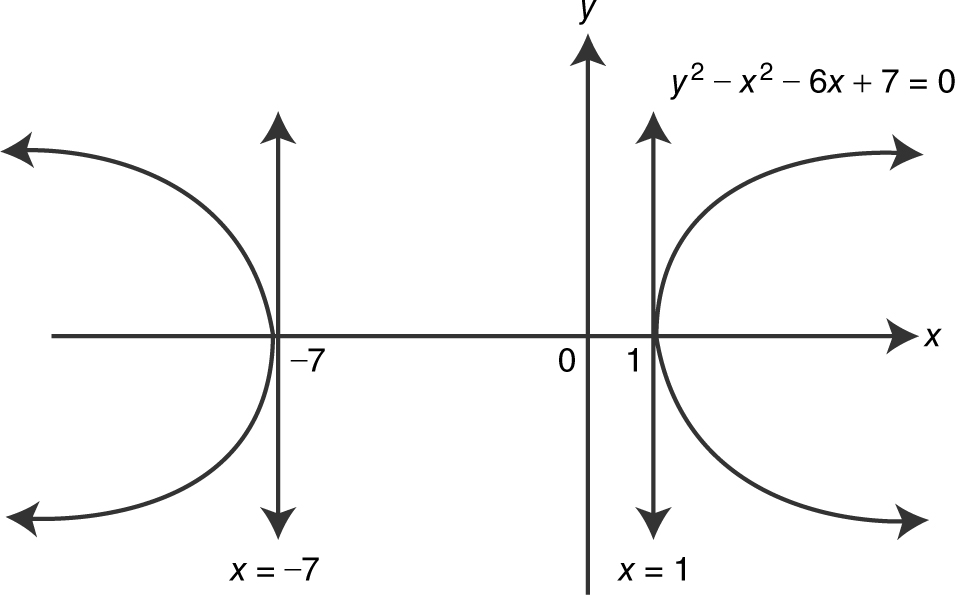
Figure 10.1-6
Step 1: Find  .
.
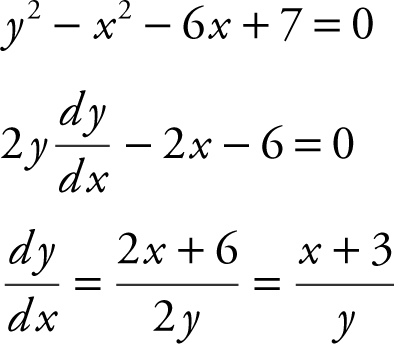
Step 2: Find  .
.
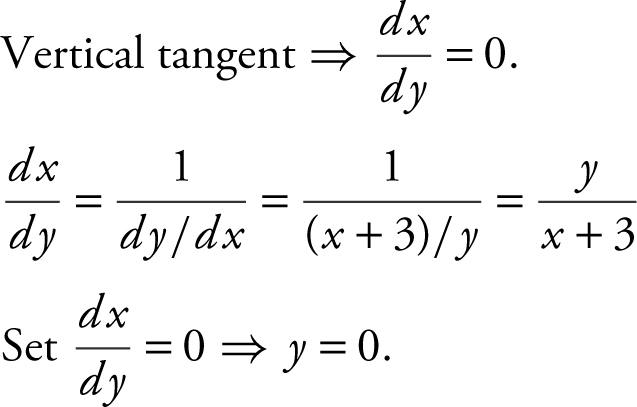
Step 3: Find points of tangency.
At y = 0, y 2 – x 2 – 6x + 7 = 0 becomes –x 2 – 6x + 7 = 0 ⇒ x 2 + 6x – 7 = 0 ⇒ (x + 7)(x – 1) = 0 ⇒ x = –7 or x = 1.
Thus, the points of tangency are (–7, 0) and (1, 0).
Step 4: Write equations for vertical tangents: x = –7 and x = 1.
Example 4
Find all points on the graph of y = |xex | at which the graph has a horizontal tangent.
Step 1: Find  .
.
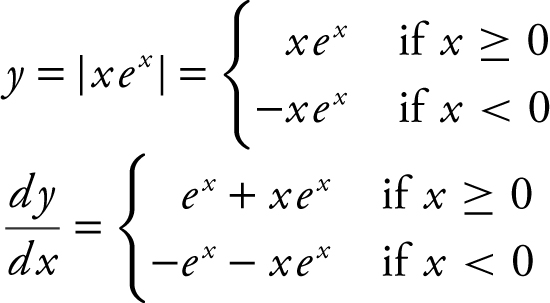
Step 2: Find the x -coordinate of points of tangency.
Horizontal tangent 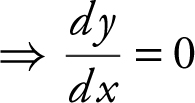 .
.
If x ≥ 0, set ex + xex = 0 ⇒ ex (1 + x ) = 0 ⇒ x = –1 but x ≥ 0, therefore, no solution.
If x < 0, set –ex – xex = 0 ⇒ –ex (1 + x ) = 0 ⇒ x = –1.
Step 3: Find points of tangency.
At 
Thus at the point (–1, 1/e ), the graph has a horizontal tangent. (See Figure 10.1-7 .)
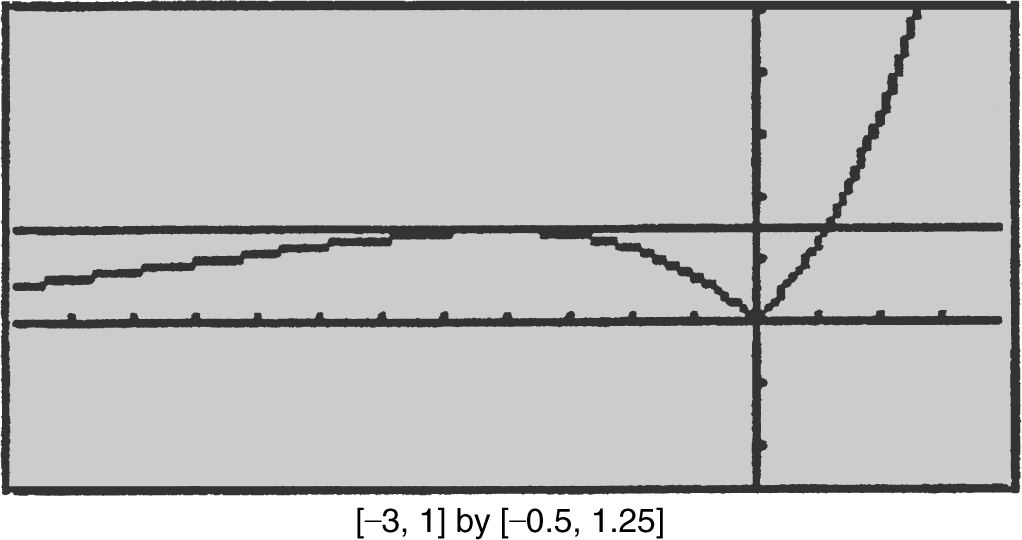
Figure 10.1-7
Example 5
Using your calculator, find the value(s) of x to the nearest hundredth at which the slope of the line tangent to the graph of y = 2 ln (x 2 + 3) is equal to  . (See Figures 10.1-8 and 10.1-9 .)
. (See Figures 10.1-8 and 10.1-9 .)
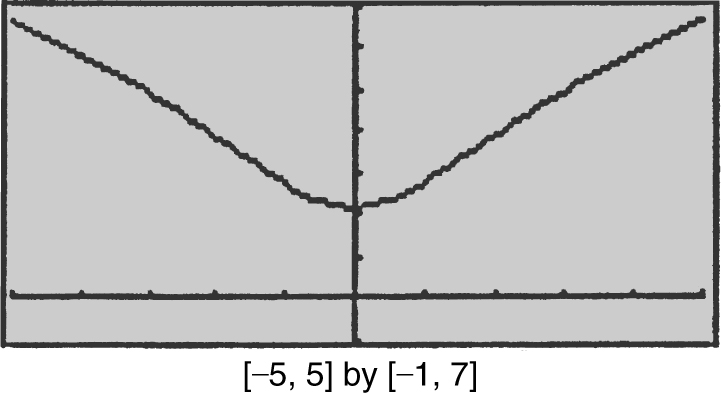
Figure 10.1-8
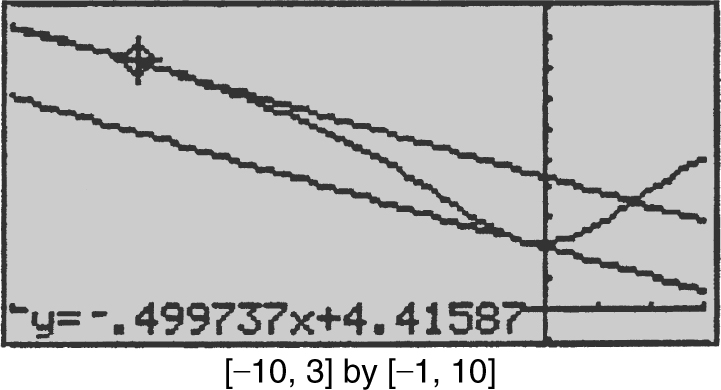
Figure 10.1-9
Step 1: Enter y 1 = 2 ∗ ln (x ^2 + 3).
Step 2: Enter y 2 = d (y 1 (x ), x ) and enter 
Step 3: Using the [Intersection ] function of the calculator for y 2 and y 3 , you obtain x = –7.61 or x = –0.39.
Example 6
Using your calculator, find the value(s) of x at which the graphs of y = 2x 2 and y = ex have parallel tangents.
Step 1: Find  for both y = 2x 2 and y = ex .
for both y = 2x 2 and y = ex .
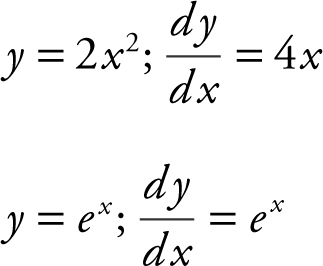
Step 2: Find the x -coordinate of the points of tangency. Parallel tangents ⇒ slopes are equal.
Set 4x = ex ⇒ 4x – ex = 0.
Using the [Solve ] function of the calculator, enter [Solve ] (4x – e ^(x ) = 0, x ) and obtain x = 2.15 and x = 0.36.

• Watch out for different units of measure, e.g., the radius, r , is 2 feet, find  in inches per second.
in inches per second.
Normal Lines
The normal line to the graph of f at the point (x 1 , y 1 ) is the line perpendicular to the tangent line at (x 1 , y 1 ). (See Figure 10.1-10 .)
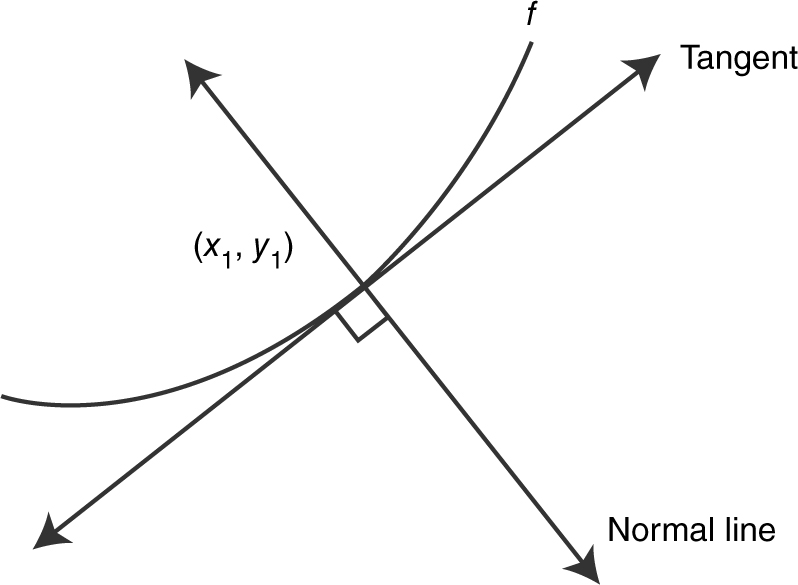
Figure 10.1-10
Note that the slope of the normal line and the slope of the tangent line at any point on the curve are negative reciprocals, provided that both slopes exist.
(m normal line )(m tangent line ) = –1.
Special Cases:
(See Figure 10.1-11 .)
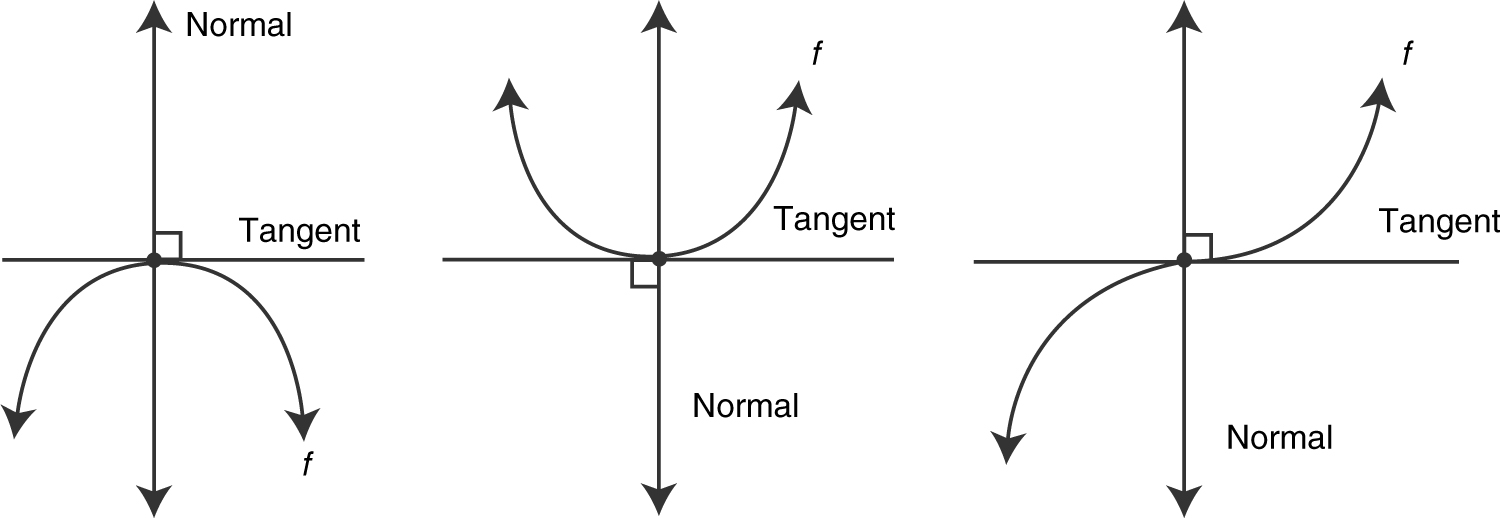
Figure 10.1-11
At these points, m tangent = 0; but m normal does not exist.
(See Figure 10.1-12 .)
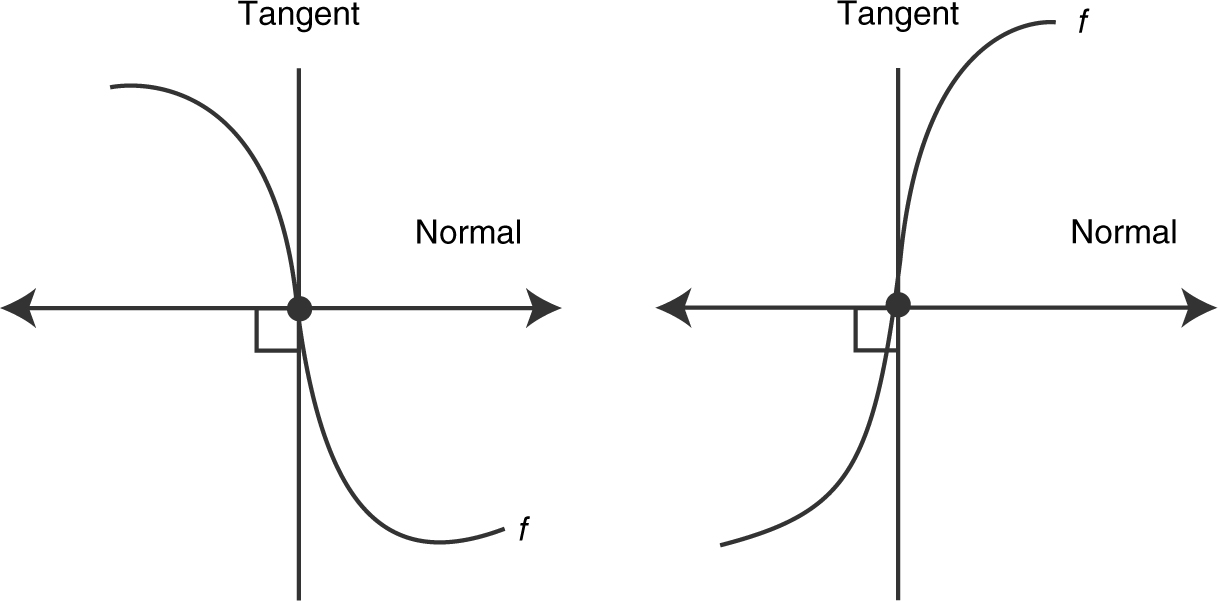
Figure 10.1-12
At these points, m tangent does not exist; however m normal = 0.
Example 1
Write an equation for each normal to the graph of y = 2 sin x for 0 ≤ x ≤ 2π that has a slope of ![]() .
.
Step 1: Find m tangent .

Step 2: Find m normal .

⇒ x = cos–1 (–1) or x = π . (See Figure10.1-13 .)
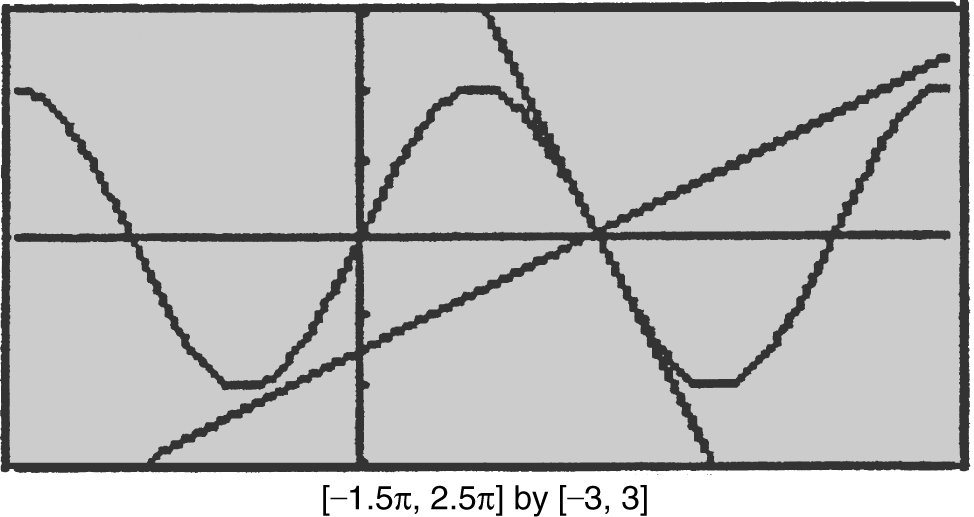
Figure 10.1-13
Step 3: Write equation of normal line.
At x = π , y = 2 sin x = 2(0) = 0; (π , 0).
Since  , equation of normal is:
, equation of normal is:
 or
or  .
.
Example 2
Find the point on the graph of y = ln x such that the normal line at this point is parallel to the line y = –ex – 1.
Step 1: Find m tangent .

Step 2: Find m normal .

Slope of y = –ex – 1 is –e .
Since normal is parallel to the line y = –ex – 1, set m normal = –e ⇒ –x = –e or x = e .
Step 3: Find the point on the graph. At x = e , y = ln x = ln e = l . Thus the point of the graph of y = ln x at which the normal is parallel to y = –ex – 1 is (e , 1). (See Figure 10.1-14 .)
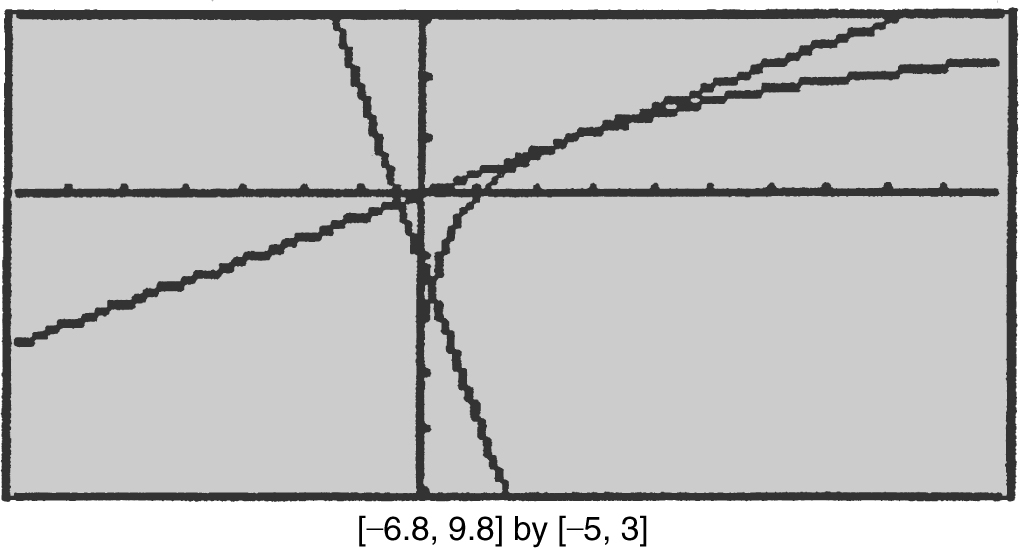
Figure 10.1-14
Example 3
Given the curve  : (a) write an equation of the normal to the curve
: (a) write an equation of the normal to the curve  at the point (2, 1/2), and (b) does this normal intersect the curve at any other point? If yes, find the point.
at the point (2, 1/2), and (b) does this normal intersect the curve at any other point? If yes, find the point.
Step 1: Find m tangent .

Step 2: Find m normal .

Step 3: Write equation of normal.
m normal = 4; (2, 1/2)
Equation of normal:  , or
, or 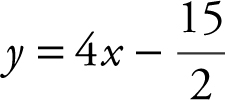 .
.
Step 4: Find other points of intersection.

Using the [Intersection ] function of your calculator, enter 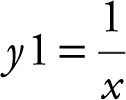 and
and  and obtain x = –0.125 and y = –8. Thus, the normal line intersects the graph of
and obtain x = –0.125 and y = –8. Thus, the normal line intersects the graph of 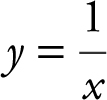 at the point (–0.125, –8) as well.
at the point (–0.125, –8) as well.

• Remember that 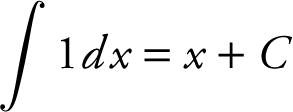 and
and 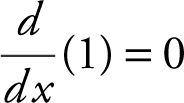 .
.
10.2 Linear Approximations
Main Concepts: Tangent Line Approximation, Estimating the n th Root of a Number, Estimating the Value of a Trigonometric Function of an Angle
Tangent Line Approximation (or Linear Approximation)
An equation of the tangent line to a curve at the point (a , f (a )) is: y = f (a ) + f ′ (a )(x – a ), providing that f is differentiable at a . (See Figure 10.2-1 .) Since the curve of f (x ) and the tangent line are close to each other for points near x = a , f (x ) ≈ f (a ) + f ′ (a )(x – a ).
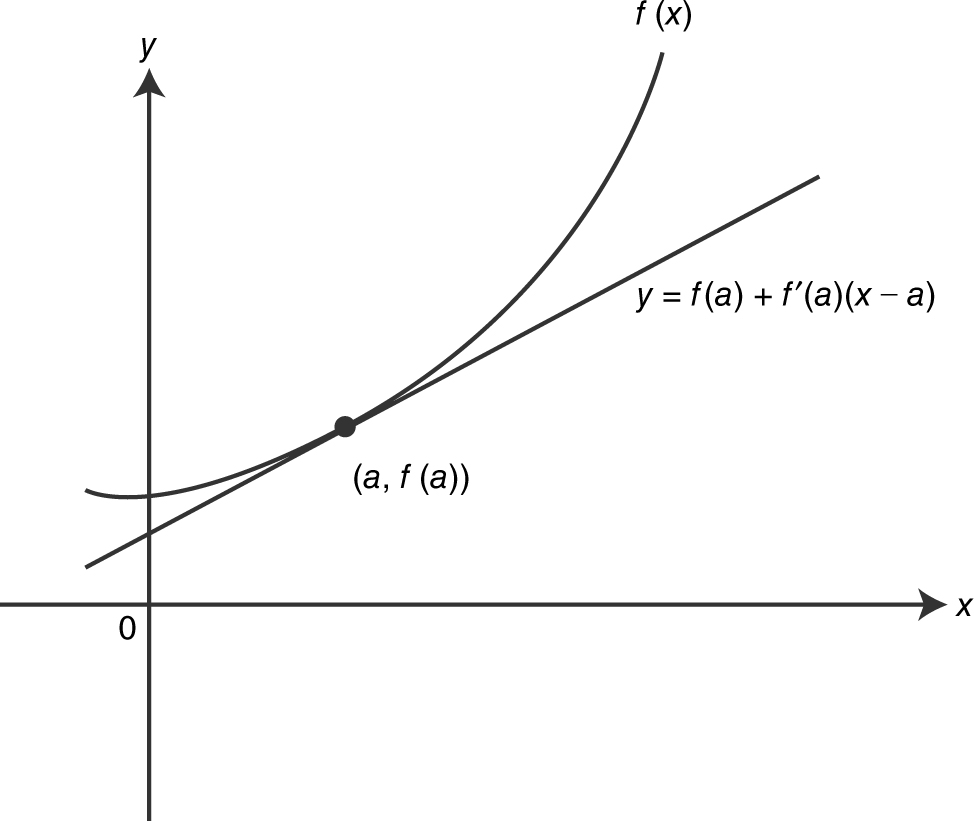
Figure 10.2-1
Example 1
Write an equation of the tangent line to f (x ) = x 3 at (2, 8). Use the tangent line to find the approximate values of f (1.9) and f (2.01).
Differentiate f (x ): f ′(x ) = 3x 2 ; f ′(2) = 3(2)2 = 12. Since f is differentiable at x = 2, an equation of the tangent at x = 2 is:
y = f (2) + f ′ (2)(x – 2)
y = (2)3 + 12(x – 2) = 8 + 12x – 24 = 12x – 16
f (1.9) ≈ 12(1.9) – 16 = 6.8
f (2.01) ≈ 12(2.01) – 16 = 8.12. (See Figure 10.2-2 .)
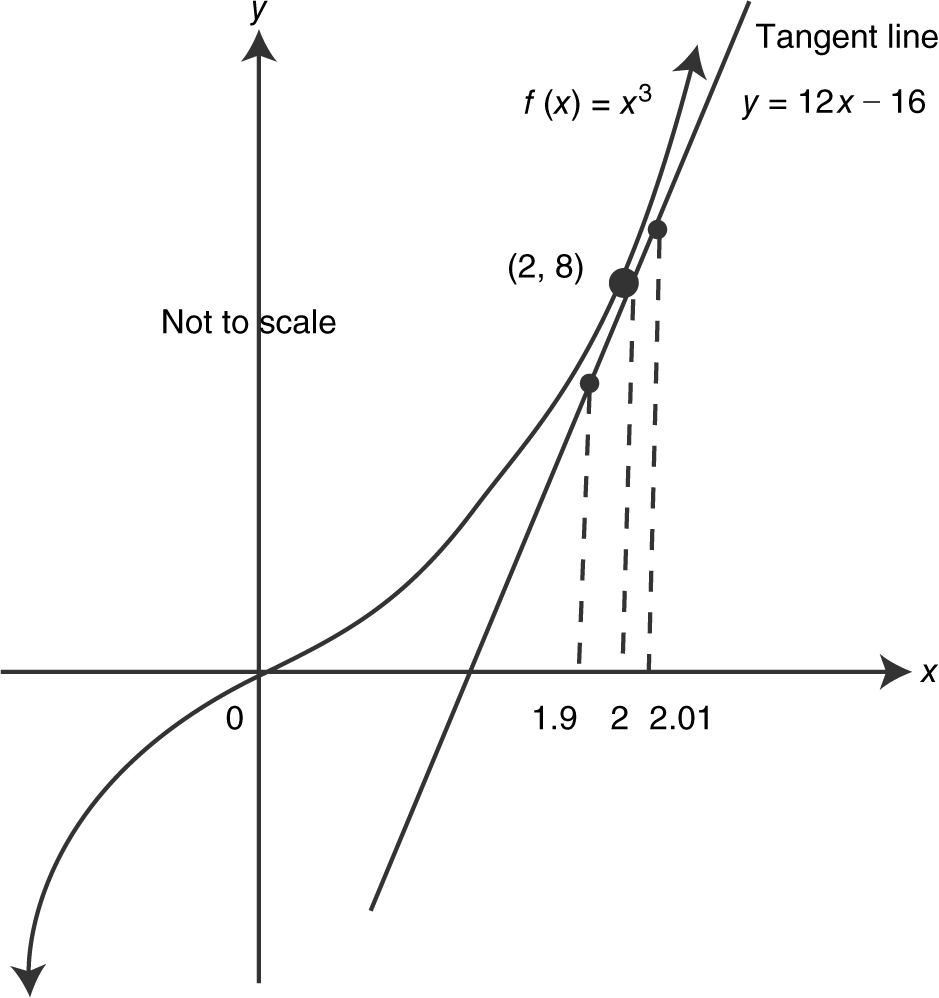
Figure 10.2-2
Example 2
If f is a differentiable function and f (2) = 6 and  , find the approximate value of f (2.1).
, find the approximate value of f (2.1).
Using tangent line approximation, you have
(a) f (2) = 6 ⇒ the point of tangency is (2, 6);
(b)  ⇒ the slope of the tangent at x = 2 is
⇒ the slope of the tangent at x = 2 is  ;
;
(c) the equation of the tangent is  or
or  ;
;
(d) thus,  .
.
Example 3
The slope of a function at any point (x , y ) is 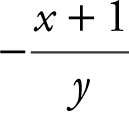 . The point (3, 2) is on the graph of f . (a) Write an equation of the line tangent to the graph of f at x = 3. (b) Use the tangent line in part (a) to approximate f (3.1).
. The point (3, 2) is on the graph of f . (a) Write an equation of the line tangent to the graph of f at x = 3. (b) Use the tangent line in part (a) to approximate f (3.1).
(a) Let y = f (x ), then 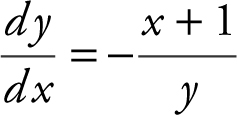

Equation of tangent: y – 2 = –2(x – 3) or y = –2x + 8.
(b) f (3.1) ≈ –2(3.1) + 8 ≈ 1.8
Estimating the n th Root of a Number
Another way of expressing the tangent line approximation is: f (a + Δx ) ≈ f (a ) + f ′(a )Δx , where Δx is a relatively small value.
Example 1
Find the approximate value of ![]() using linear approximation.
using linear approximation.
Using  and Δx = 1.
and Δx = 1.
Thus, 
Example 2
Find the approximate value of ![]() using linear approximation.
using linear approximation.
Let f (x ) = x 1/3 , a = 64, Δx = – 2. Since  and
and  , you can use f (a + Δx ) ≈ f (a ) + f ′(a )Δx . Thus, f (62) =
, you can use f (a + Δx ) ≈ f (a ) + f ′(a )Δx . Thus, f (62) = 

• Use calculus notations and not calculator syntax, e.g., write 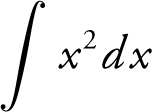 and not
and not 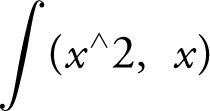 .
.
Estimating the Value of a Trigonometric Function of an Angle
Example
Approximate the value of sin 31°.
Note: You must express the angle measurement in radians before applying linear approximations.  radians and
radians and  radians.
radians.
Let f (x ) = sin x ,  and
and  .
.
Since f ′ (x ) = cos x and  , you can use linear approximations:
, you can use linear approximations:
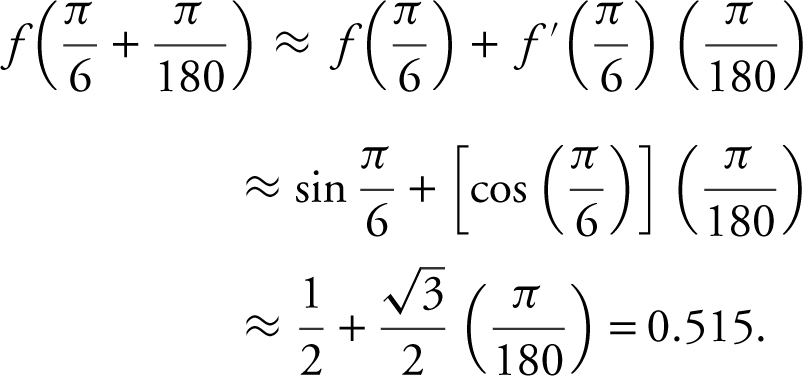
10.3 Motion Along a Line
Main Concepts: Instantaneous Velocity and Acceleration, Vertical Motion, Horizontal Motion
Instantaneous Velocity and Acceleration

Example 1
The position function of a particle moving on a straight line is s (t ) = 2t 3 – 10t 2 + 5. Find (a) the position, (b) instantaneous velocity, (c) acceleration, and (d) speed of the particle at t = 1.
Solution:
(a) s (1) = 2(1)3 – 10(1)2 + 5 = –3
(b) v (t ) = s ′(t ) = 6t 2 – 20t
v (1) = 6(1)2 – 20(1) = –14
(c) a (t ) = v ′(t ) = 12t – 20
a (1) = 12(1) – 20 = –8
(d) Speed = |v (t )| = |v (1)| = 14
Example 2
The velocity function of a moving particle is  for 0 ≤ t ≤ 7.
for 0 ≤ t ≤ 7.
What is the minimum and maximum acceleration of the particle on 0 ≤ t ≤ 7?
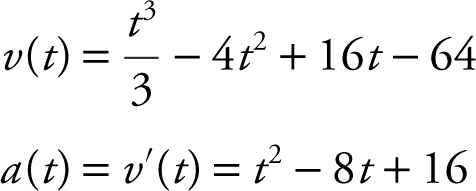
(See Figure 10.3-1 .) The graph of a (t ) indicates that:
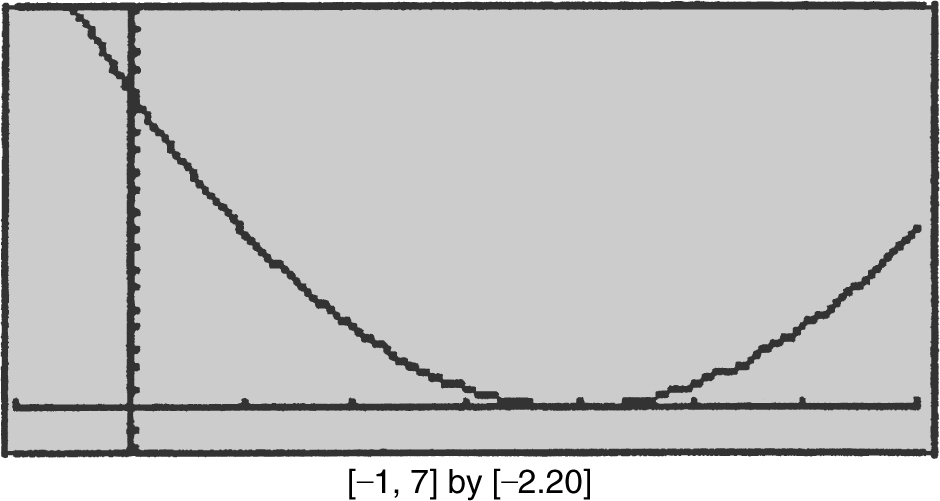
Figure 10.3-1
(1) The minimum acceleration occurs at t = 4 and a (4) = 0.
(2) The maximum acceleration occurs at t = 0 and a (0) = 16.
Example 3
The graph of the velocity function is shown in Figure 10.3-2 .
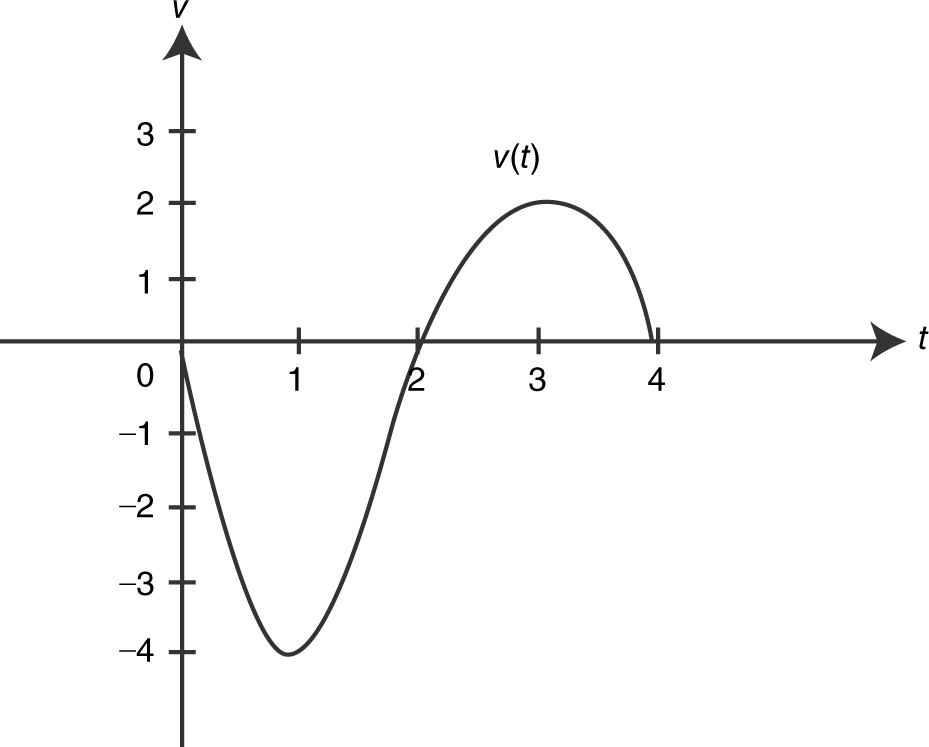
Figure 10.3-2
(a) When is the acceleration 0?
(b) When is the particle moving to the right?
(c) When is the speed the greatest?
Solution:
(a) a (t ) = v ′(t ) and v ′(t ) is the slope of tangent to the graph of v . At t = 1 and t = 3, the slope of the tangent is 0.
(b) For 2 < t < 4, v (t ) > 0. Thus the particle is moving to the right during 2 < t < 4.
(c) Speed = |v (t )| at t = 1, v (t ) = –4.
Thus, speed at t = 1 is |–4| = 4 which is the greatest speed for 0 ≤ t ≤ 4.

• Use only the four specified capabilities of your calculator to get your answer: plotting graphs, finding zeros, calculating numerical derivatives, and evaluating definite integrals. All other built-in capabilities can only be used to check your solution.
Vertical Motion
Example
From a 400-foot tower, a bowling ball is dropped. The position function of the bowling ball s (t ) = –16t 2 + 400, t ≥ 0 is in seconds. Find:
(a) the instantaneous velocity of the ball at t = 2 seconds.
(b) the average velocity for the first 3 seconds.
(c) when the ball will hit the ground.
Solution:
(a) v (t ) = s ′(t ) = –32t
v (2) = 32(2) = –64 ft/sec
(b) Average velocity  .
.
(c) When the ball hits the ground, s (t ) = 0.
Thus, set s (t ) = 0 ⇒ –16t 2 + 400 = 0; 16t 2 = 400; t = ±5.
Since t ≥ 0, t = 5. The ball hits the ground at t = 5 sec.

• Remember that the volume of a sphere is 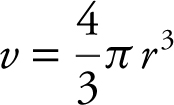 and the surface area is s = 4πr 2 . Note that v ′ = s .
and the surface area is s = 4πr 2 . Note that v ′ = s .
Horizontal Motion
Example
The position function of a particle moving in a straight line is s (t ) = t 3 – 6t 2 + 9t – 1, t ≥ 0. Describe the motion of the particle.
Step 1: Find v (t ) and a (t ).
v (t ) = 3t 2 – 12t + 9
a (t ) = 6t – 12
Step 2: Set v (t ) and a (t ) = 0.

Step 3: Determine the directions of motion. (See Figure 10.3-3 .)
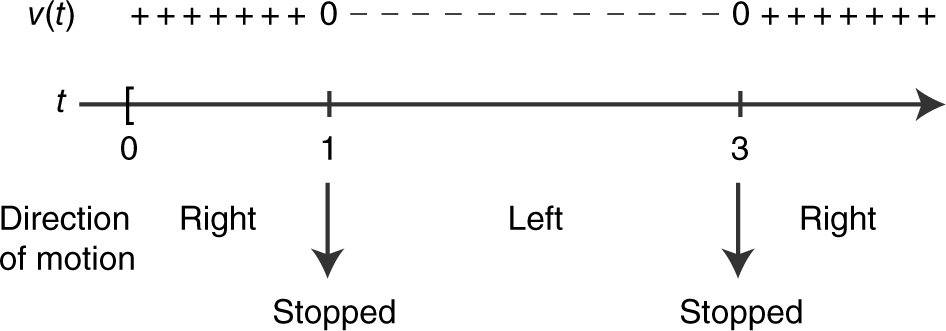
Figure 10.3-3
Step 4: Determine acceleration. (See Figure 10.3-4 .)
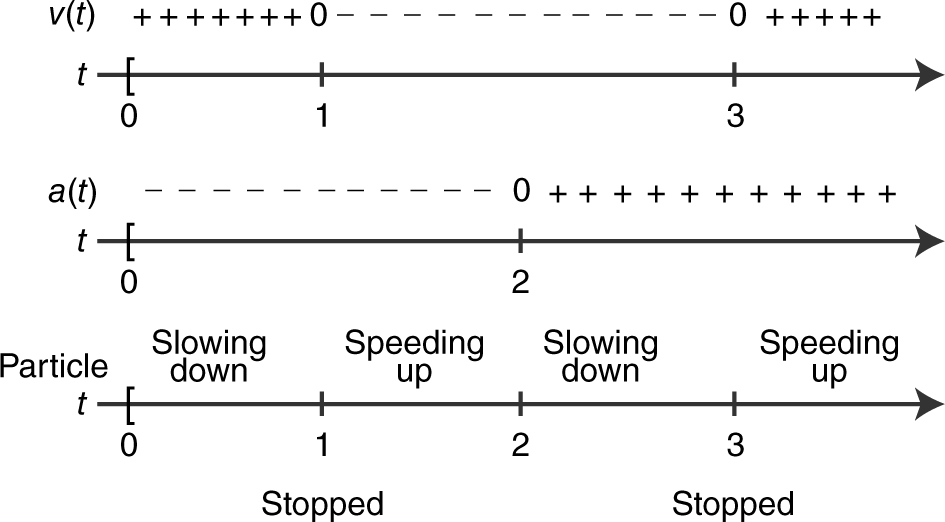
Figure 10.3-4
Step 5: Draw the motion of the particle. (See Figure 10.3-5 .) s (0) = –1, s (1) = 3, s (2) = 1 and s (3) = –1

Figure 10.3-5
At t = 0, the particle is at –1 and moving to the right. It slows down and stops at t = 1 and at t = 3. It reverses direction (moving to the left) and speeds up until it reaches 1 at t = 2. It continues moving left but slows down and stops at –1 at t = 3. Then it reverses direction (moving to the right) again and speeds up indefinitely. (Note: “Speeding up” is defined as when |v (t )| increases and “slowing down” is defined as when |v (t )| decreases.)
10.4 Rapid Review
1. Write an equation of the normal line to the graph y = ex at x = 0.
Answer : 
At x = 0, y = e 0 = 1 ⇒ you have the point (0, 1).
Equation of normal: y – 1 = –1(x – 0) or y = –x + 1.
2. Using your calculator, find the values of x at which the function y = –x 2 + 3x and y = ln x have parallel tangents.
Answer : 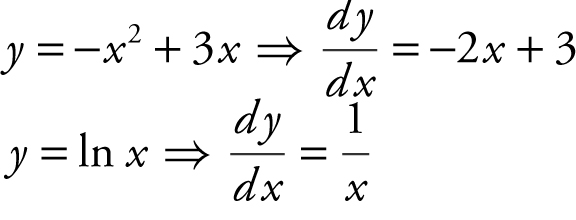
Set 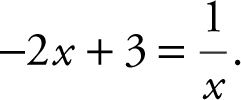 Using the [Solve ] function on your calculator, enter
Using the [Solve ] function on your calculator, enter
[Solve ] 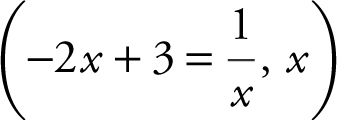 and obtain x = 1 or
and obtain x = 1 or 
3. Find the linear approximation of f (x ) = x 3 at x = 1 and use the equation to find f (1.1).
Answer : f (1) = 1 ⇒ (1, 1) is on the tangent line and f ′(x ) = 3x 2 ⇒ f ′(1) = 3.
y – 1 = 3(x – 1) or y = 3x – 2.
f (1.1) ≈ 3(1.1) – 2 ≈ 1.3
4. (See Figure 10.4-1 .)
(a) When is the acceleration zero? (b) Is the particle moving to the right or left?
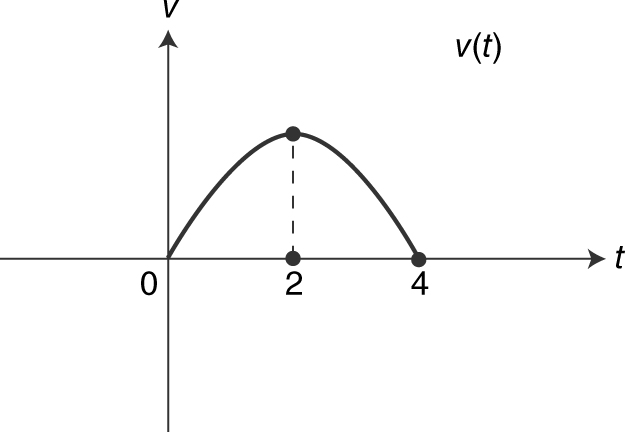
Figure 10.4-1
Answer : (a) a (t ) = v ′(t ) and v ′(t ) is the slope of the tangent. Thus, a (t ) = 0 at t = 2.
(b) Since v (t ) ≥ 0, the particle is moving to the right.
5. Find the maximum acceleration of the particle whose velocity function is v (t ) = t 2 + 3 on the interval 0 ≤ t ≤ 4.
Answer : a (t ) = v ′(t ) = 2(t ) on the interval 0 ≤ t ≤ 4, a (t ) has its maximum value at t = 4. Thus a (t ) = 8. The maximum acceleration is 8.
10.5 Practice Problems
Part A—The use of a calculator is not allowed.
1 . Find the linear approximation of f (x ) = (1 + x )1/4 at x = 0 and use the equation to approximate f (0.1).
2 . Find the approximate value of ![]() using linear approximation.
using linear approximation.
3 . Find the approximate value of cos 46° using linear approximation.
4 . Find the point on the graph of y = |x 3 | such that the tangent at the point is parallel to the line y – 12x = 3.
5 . Write an equation of the normal to the graph of y = ex at x = ln 2.
6 . If the line y – 2x = b is tangent to the graph y = –x 2 + 4, find the value of b .
7 . If the position function of a particle 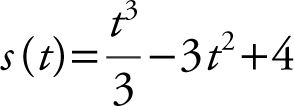 , find the velocity and position of particle when its acceleration is 0.
, find the velocity and position of particle when its acceleration is 0.
8 . The graph in Figure 10.5-1 represents the distance in feet covered by a moving particle in t seconds. Draw a sketch of the corresponding velocity function.
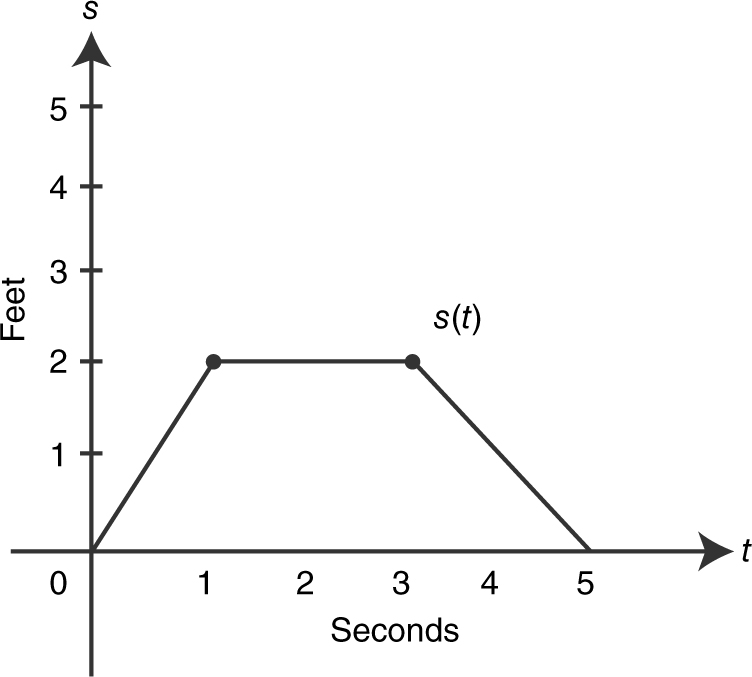
Figure 10.5-1
9 . The position function of a moving particle is shown in Figure 10.5-2 .
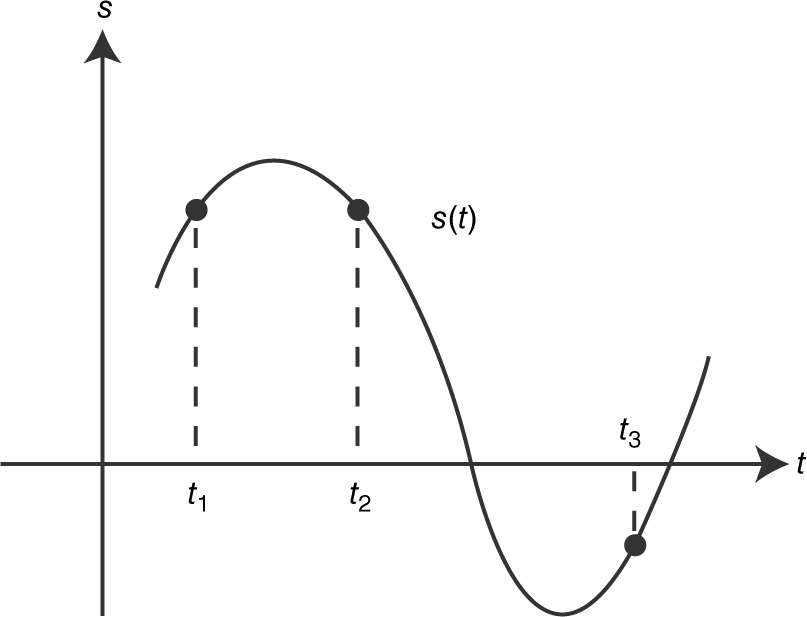
Figure 10.5-2
For which value(s) of t (t 1 , t 2 , t 3 ) is:
(a) the particle moving to the left?
(b) the acceleration negative?
(c) the particle moving to the right and slowing down?
10 . The velocity function of a particle is shown in Figure 10.5-3 .
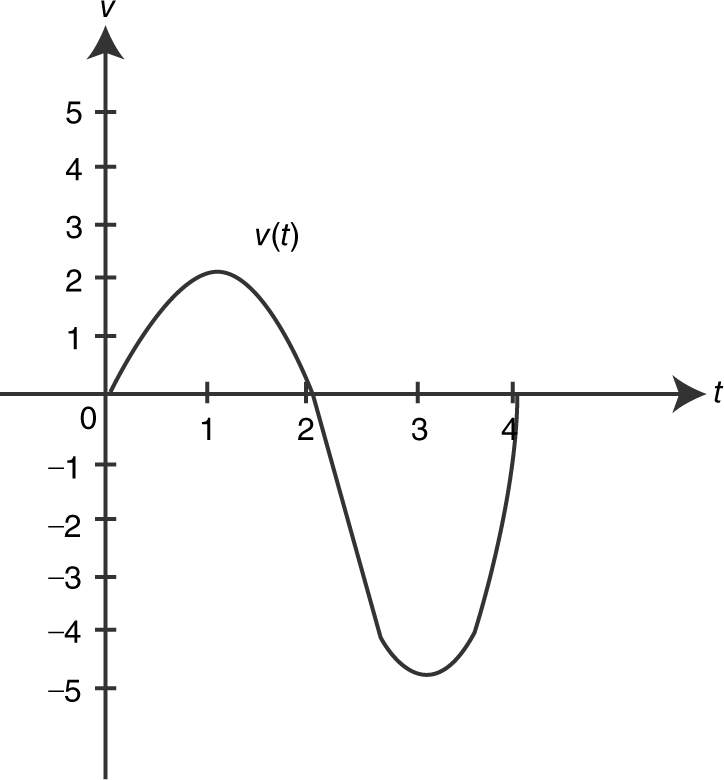
Figure 10.5-3
(a) When does the particle reverse direction?
(b) When is the acceleration 0?
(c) When is the speed the greatest?
11 . A ball is dropped from the top of a 640-foot building. The position function of the ball is s (t ) = –16t 2 + 640, where t is measured in seconds and s (t ) is in feet. Find:
(a) The position of the ball after 4 seconds.
(b) The instantaneous velocity of the ball at t = 4.
(c) The average velocity for the first 4 seconds.
(d) When the ball will hit the ground.
(e) The speed of the ball when it hits the ground.
12 . The graph of the position function of a moving particle is shown in Figure 10.5-4 .
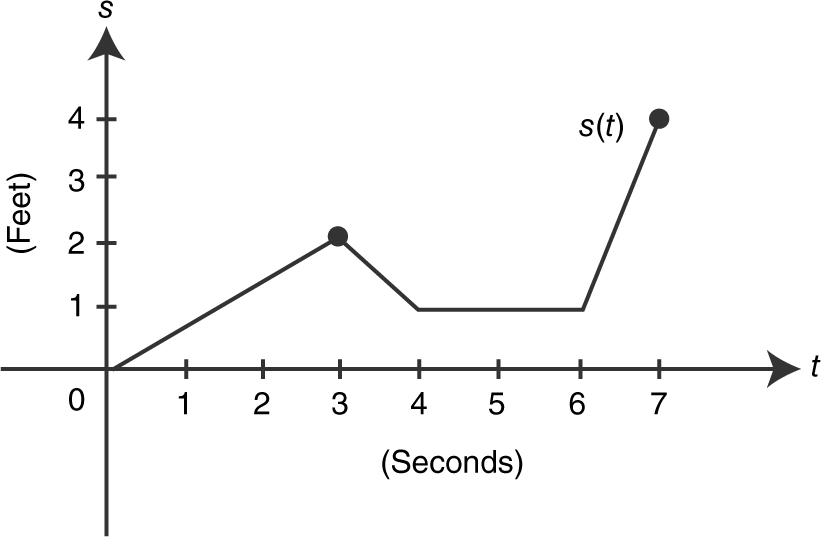
Figure 10.5-4
(a) What is the particle’s position at t = 5?
(b) When is the particle moving to the left?
(c) When is the particle standing still?
(d) When does the particle have the greatest speed?
Part B—Calculators are allowed.
13 . The position function of a particle moving on a line is s (t ) = t 3 – 3t 2 + 1, t ≥ 0 where t is measured in seconds and s in meters. Describe the motion of the particle.
14 . Find the linear approximation of f (x ) = sin x at x = π . Use the equation to find the approximate value of 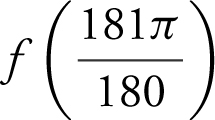 .
.
15 . Find the linear approximation of f (x ) = ln (1 + x ) at x = 2.
16 . Find the coordinates of each point on the graph of y 2 = 4 – 4x 2 at which the tangent line is vertical. Write an equation of each vertical tangent.
17 . Find the value(s) of x at which the graphs of y = ln x and y = x 2 + 3 have parallel tangents.
18 . The position functions of two moving particles are s 1 (t ) = ln t and s 2 (t ) = sin t and the domain of both functions is 1 ≤ t ≤ 8. Find the values of t such that the velocities of the two particles are the same.
19 . The position function of a moving particle on a line is s (t ) = sin(t ) for 0 ≤ t ≤ 2π . Describe the motion of the particle.
20 . A coin is dropped from the top of a tower and hits the ground 10.2 seconds later. The position function is given as s (t ) = –16t 2 – v 0 t + s 0 , where s is measured in feet, t in seconds, and v 0 is the initial velocity and s 0 is the initial position. Find the approximate height of the building to the nearest foot.
10.6 Cumulative Review Problems
(Calculator) indicates that calculators are permitted.
21 . Find  if y = x sin–1 (2x ).
if y = x sin–1 (2x ).
22 . Given f (x ) = x 3 – 3x 2 + 3x – 1 and the point (1, 2) is on the graph of f –1 (x ). Find the slope of the tangent line to the graph of f –1 (x ) at (1, 2).
23 . Evaluate 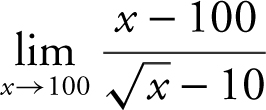 .
.
24 . A function f is continuous on the interval (–1, 8) with f (0) = 0, f (2) = 3, and f (8) = 1/2 and has the following properties:

(a) Find the intervals on which f is increasing or decreasing.
(b) Find where f has its absolute extrema.
(c) Find where f has the points of inflection.
(d) Find the intervals on which f is concave upward or downward.
(e) Sketch a possible graph of f .
25 . The graph of the velocity function of a moving particle for 0 ≤ t ≤ 8 is shown in Figure 10.6-1 . Using the graph:
(a) Estimate the acceleration when v (t ) = 3 ft/sec.
(b) Find the time when the acceleration is a minimum.
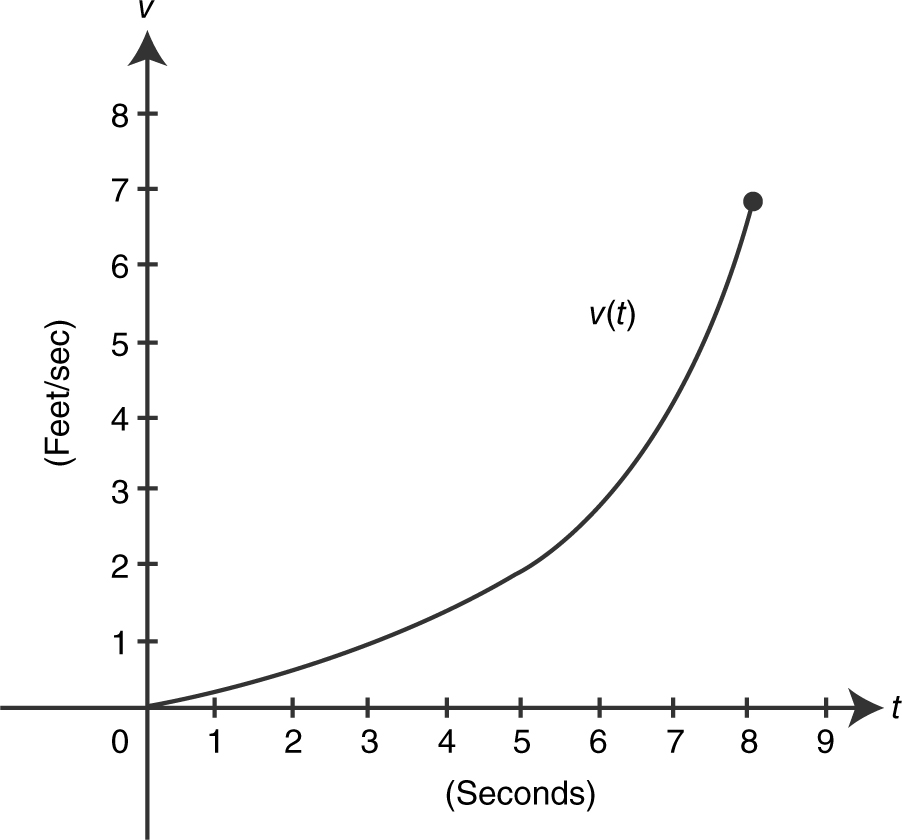
Figure 10.6-1
10.7 Solutions to Practice Problems
Part A—The use of a calculator is not allowed.
1 . Equation of tangent line:
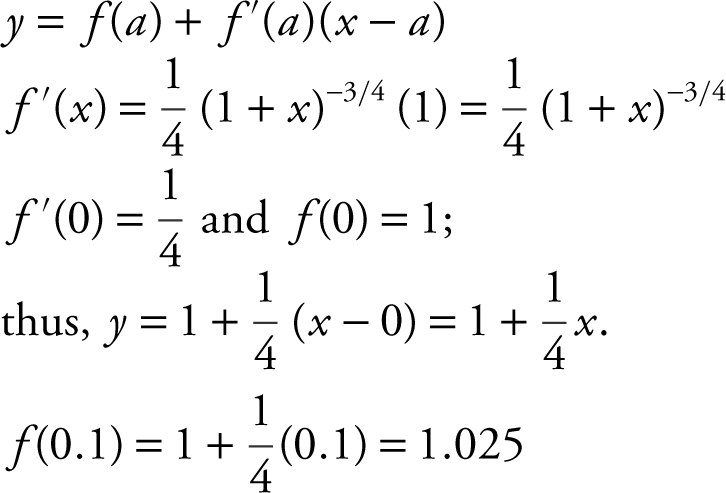
2 . f (a + Δx ) ≈ f (a ) + f ′(a )Δx
Let  and f (28) = f (27+1).
and f (28) = f (27+1).
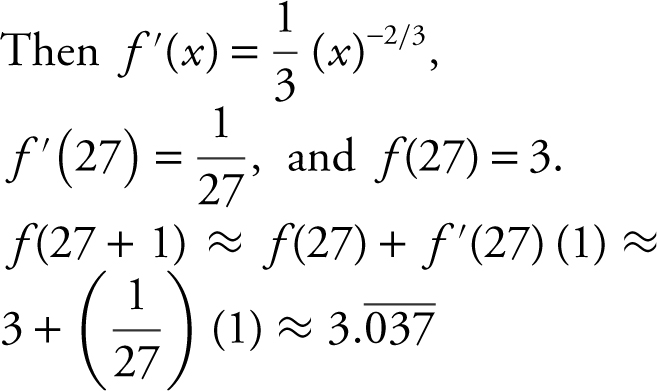
3 . f (a + Δx ) ≈ f (a ) + f ′(a ) Δx Convert to radians:

Let f (x ) = cos x and f (45°) =

Then f ′(x ) = – sin x and
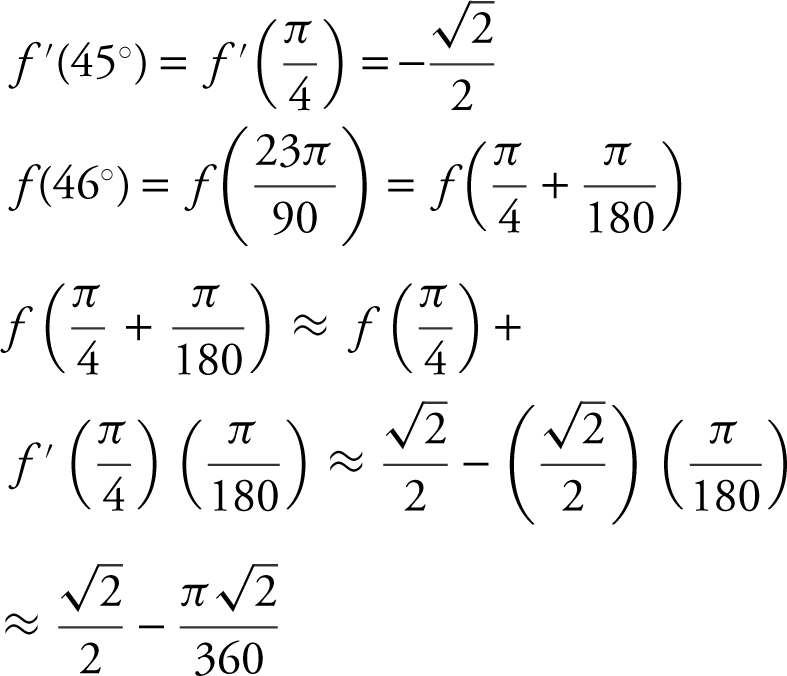
4 . Step 1: Find m tangent .
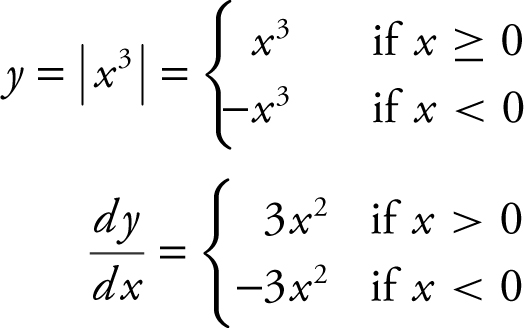
Step 2: Set m tangent = slope of line y – 12x = 3.
Since y – 12x = 3 ⇒ y = 12x + 3, then m = 12.
Set 3x 2 = 12 ⇒ x = ±2
since x ≥ 0, x = 2.
Set –3x 2 = 12 ⇒ x 2 = –4. Thus ∅.
Step 3: Find the point on the curve. (See Figure 10.7-1 .)
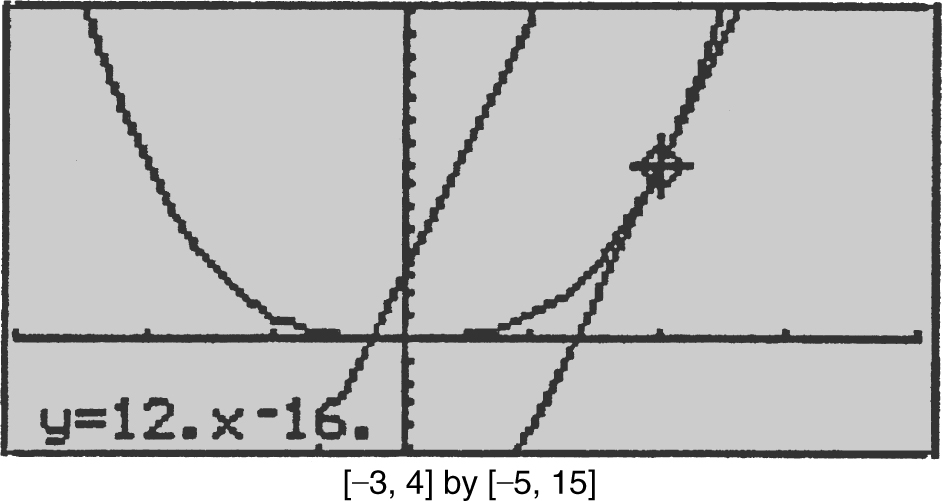
Figure 10.7-1
At x = 2, y = x 3 = 23 = 8.
Thus, the point is (2, 8).
5 . Step 1: Find m tangent .
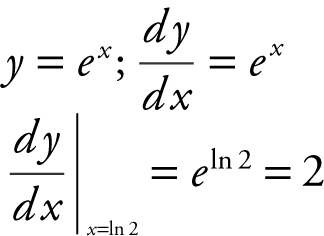
Step 2: Find m normal .
At x = ln 2, m normal = 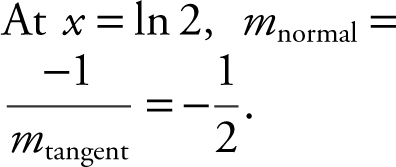
Step 3: Write equation of normal. At x = ln 2, y = ex = e ln2 = 2. Thus the point of tangency is (ln 2, 2). The equation of normal:
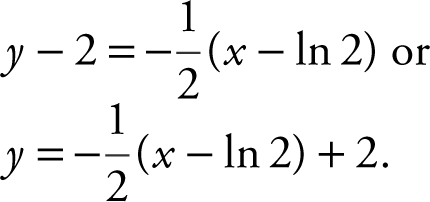
6 . Step 1: Find m tangent .

Step 2: Find the slope of line y – 2x = b
y – 2x = b ⇒
y = 2x + b or m = 2.
Step 3: Find point of tangency.
Set m tangent = slope of line y – 2x = b ⇒ – 2x = 2 ⇒ x = –1.
At x = –1, y = –x 2 + 4 = –(–1)2 + 4 = 3; (–1, 3).
Step 4: Find b .
Since the line y – 2x = b passes through the point (–1, 3), thus 3 – 2(–1) = b or b = 5.
7 . v (t ) = s ′(t ) = t 2 – 6t ;
a (t ) = v ′(t ) = s ″(t ) = 2t – 6
Set a (t ) = 0 ⇒ 2t – 6 = 0 or t = 3. v (3) = (3)2 – 6(3) = – 9; .
.
8 . On the interval (0, 1), the slope of the line segment is 2. Thus the velocity v (t ) = 2 ft/sec. On (1, 3), v (t ) = 0 and on (3, 5), v (t ) = –1. (See Figure 10.7-2 .)
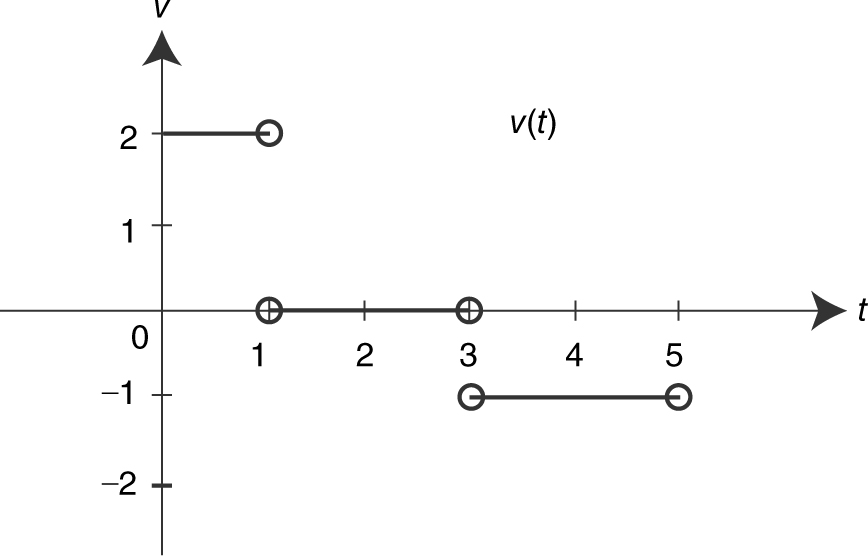
Figure 10.7-2
9 . (a) At t = t 2 , the slope of the tangent is negative. Thus, the particle is moving to the left.
(b) At t = t 1 , and at t = t 2 , the curve is concave downward 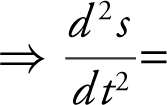 acceleration is negative.
acceleration is negative.
(c) At t = t 1 , the slope > 0 and thus the particle is moving to the right. The curve is concave downward ⇒ the particle is slowing down.
10 . (a) At t = 2, v (t ) changes from positive to negative, and thus the particle reverses its direction.
(b) At t = 1, and at t = 3, the slope of the tangent to the curve is 0. Thus, the acceleration is 0.
(c) At t = 3, speed is equal to |– 5| = 5 and 5 is the greatest speed.
11 . (a) s (4) = –16(4)2 + 640 = 384 ft
(b) v (t ) = s ′(t ) = –32t
v (4) =–32(4) ft/s = –128 ft/sec
(c) Average velocity = 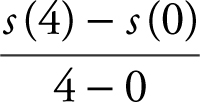

(d) Set s (t ) = 0 ⇒ –16t 2 + 640 = 0 ⇒ 16t 2 = 640 or t = ± ![]() .
.
Since t ≥ 0, or t = ± ![]() or t ≈ 6.32 sec.
or t ≈ 6.32 sec.
(e) |v (![]() )| = |–32(
)| = |–32(![]() | = | – 64
| = | – 64![]() | ft/s or ≈ 202.39 ft/sec
| ft/s or ≈ 202.39 ft/sec
12 . (a) At t = 5, s (t ) = 1.
(b) For 3 < t < 4, s (t ) decreases. Thus, the particle moves to the left when 3 < t < 4.
(c) When 4 < t < 6, the particle stays at 1.
(d) When 6 < t < 7, speed = 2 ft/sec, the greatest speed, which occurs where s has the greatest slope.
Part B—Calculators are allowed.
13 . Step 1: v (t ) = 3t 2 – 6t
a (t ) = 6t – 6
Step 2: Set v (t ) = 0 ⇒ 3t 2 – 6t = 0 ⇒ 3t (t – 2) = 0, or t = 0 or t = 2 Set a (t ) = 0 ⇒ 6t – 6 = 0 or t = 1.
Step 3: Determine the directions of motion. (See Figure 10.7-3 .)
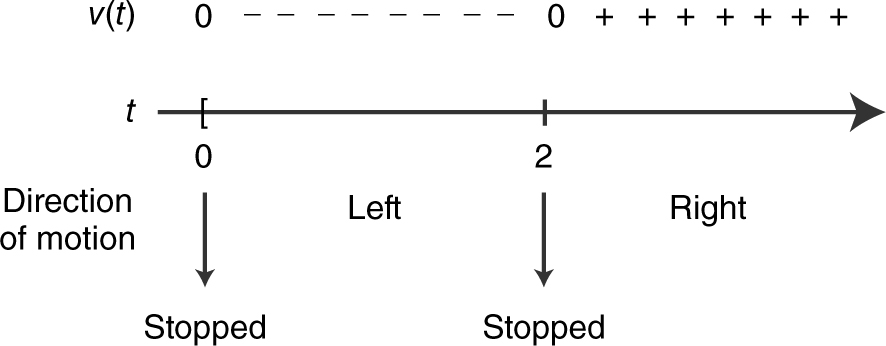
Figure 10.7-3
Step 4: Determine acceleration. (See Figure 10.7-4 .)
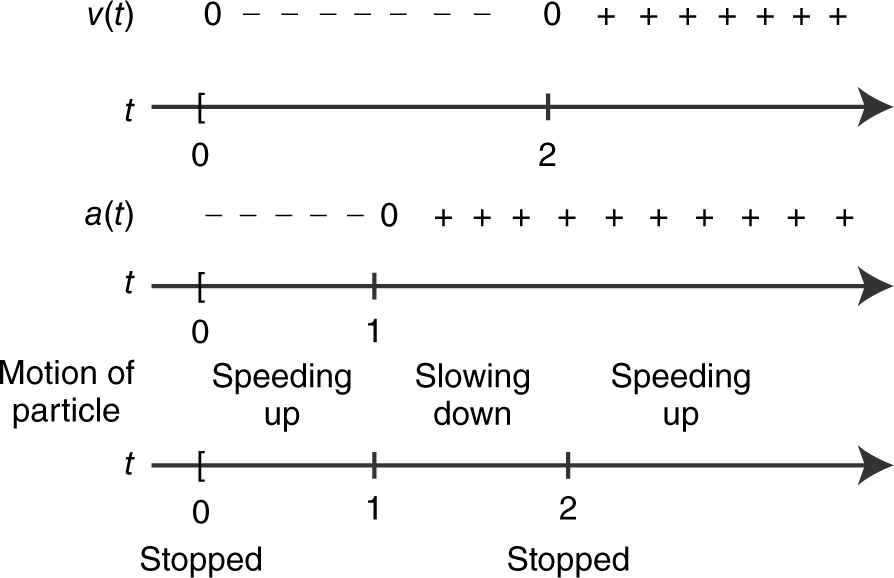
Figure 10.7-4
Step 5: Draw the motion of the particle. (See Figure 10.7-5 .) s (0) = 1, s (1) = –1, and s (2) = –3.
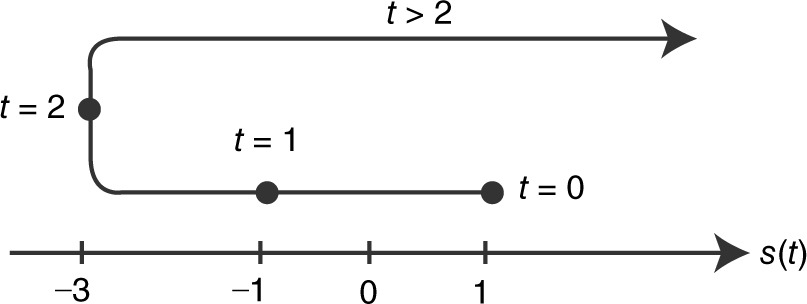
Figure 10.7-5
The particle is initially at 1 (t = 0). It moves to the left speeding up until t = 1, when it reaches –1. Then it continues moving to the left, but slowing down until t = 2 at –3. The particle reverses direction, moving to the right and speeding up indefinitely.
14 . Linear approximation:
y = f (a ) + f ′(a )(x – a ) a = π
f (x ) = sin x and f (π ) = sin π = 0
f ′(x ) = cos x and f ′(π ) = cos π = –1.
Thus, y = 0 + (–1)(x –π ) or
y = –x + π .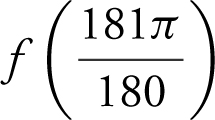 is approximately:
is approximately: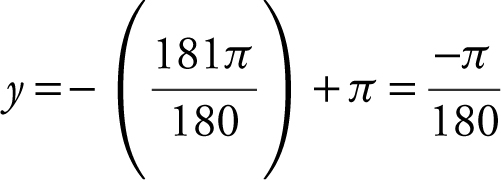 or ≈ –0.0175.
or ≈ –0.0175.
15 . y = f (a ) + f ′(a )(x – a )
f (x ) = ln (1 + x ) and f (2) = ln (1 + 2) = ln 3
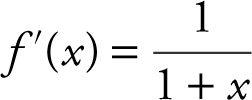 and
and 
Thus,  .
.
16 . Step 1: Find  .
.
y 2 = 4 – 4x 2 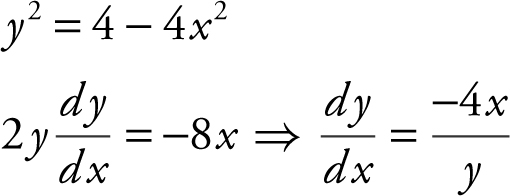
Step 2: Find  .
.

Set 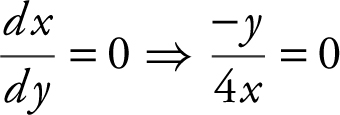 or y = 0.
or y = 0.
Step 3: Find points of tangency.
At y = 0, y 2 = 4 – 4x 2 becomes 0 = 4 – 4x 2
⇒ x = ±1.
Thus, points of tangency are (1, 0) and (–1, 0).
Step 4: Write equations of vertical tangents x = 1 and x = –1.
17 . Step 1: Find  for y = ln x and y = x2 + 3.
for y = ln x and y = x2 + 3.
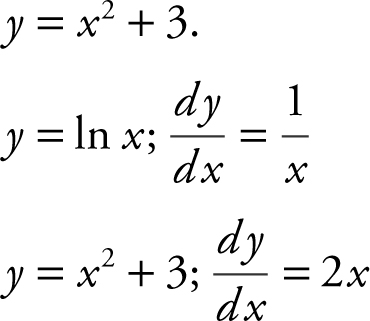
Step 2: Find the x -coordinate of point(s) of tangency.
Parallel tangents ⇒ slopes are equal. Set  .
.
Using the [Solve ] function of your calculator, enter [Solve ] 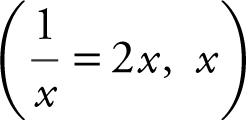 and obtain
and obtain 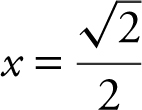 or
or 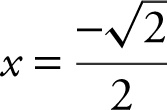 . Since for y = ln x ,
. Since for y = ln x , 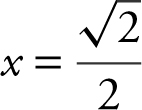 .
.
18 . s 1 (t ) = ln t and  .
.
s 2 (t ) = sin(t ) and
s ′2 (t ) = cos(t ); 1 ≤ t ≤ 8.
Enter  and y 2 = cos(x ). Use the [Intersection ] function of the calculator and obtain t = 4.917 and t = 7.724.
and y 2 = cos(x ). Use the [Intersection ] function of the calculator and obtain t = 4.917 and t = 7.724.
19 . Step 1: s (t ) = sin t
v (t ) = cos t
a (t ) = – sin t
Step 2: Set v (t ) = 0 ⇒ cos t = 0; and
and  .
.
Set a (t ) = 0 ⇒ – sin t = 0; t =π and 2π.
Step 3: Determine the directions of motion. (See Figure 10.7-6 .)
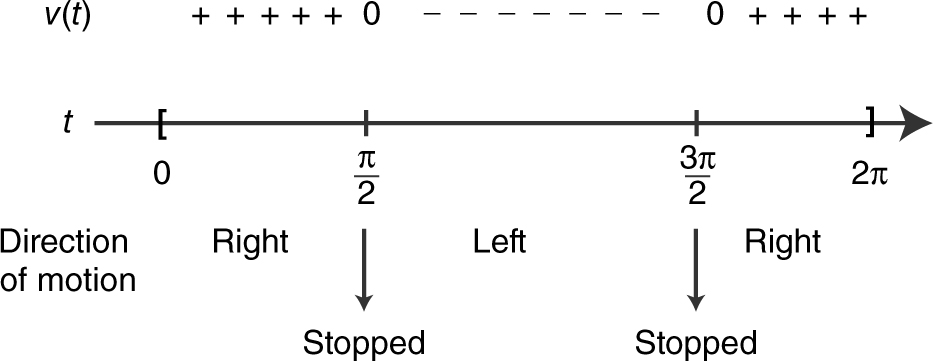
Figure 10.7-6
Step 4: Determine acceleration. (See Figure 10.7-7 .)
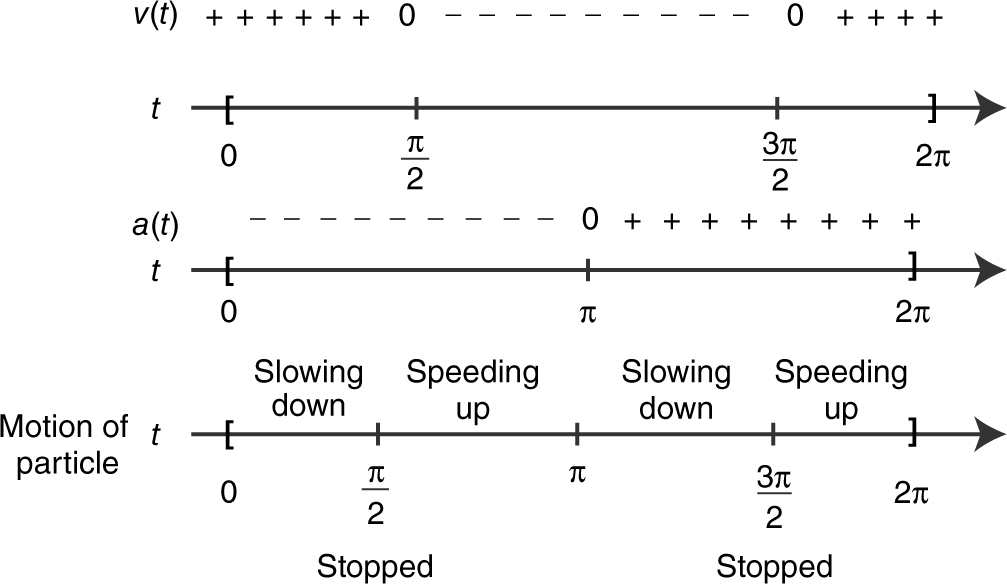
Figure 10.7-7
Step 5: Draw the motion of the particle. (See Figure 10.7-8 .)
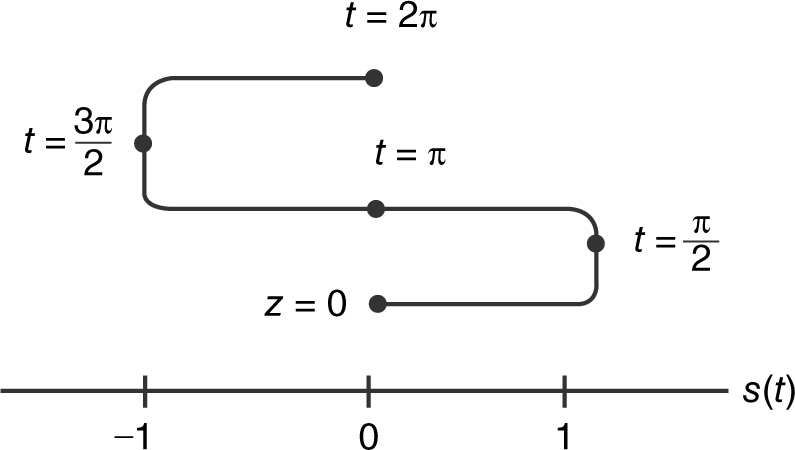
Figure 10.7-8
The particle is initially at 0, s (0) = 0. It moves to the right but slows down to a stop at 1 when  = 1. It then turns and moves to the left speeding up until it reaches 0, when t = π, s (π) = 0 and continues to the left, but slowing down to a stop at – 1 when
= 1. It then turns and moves to the left speeding up until it reaches 0, when t = π, s (π) = 0 and continues to the left, but slowing down to a stop at – 1 when  . It then turns around again, moving to the right, speeding up to 0 when t = 2π, s (2π) = 0.
. It then turns around again, moving to the right, speeding up to 0 when t = 2π, s (2π) = 0.
20 . s (t ) = – 16t 2 + v 0 t + s 0
s 0 = height of building and v 0 = 0.
Thus, s (t ) =– 16t 2 + s 0 .
When the coin hits the ground, s (t ) = 0, t = 10.2. Thus, set s (t ) = 0 ⇒ – 16t 2 + s 0 = 0 ⇒ – 16(10.2)2 + s 0 = 0 s 0 = 1664.64 ft. The building is approximately 1665 ft tall.
10.8 Solutions to Cumulative Review Problems
21 . Using product rule, let u = x ; v = sin–1 (2x ).
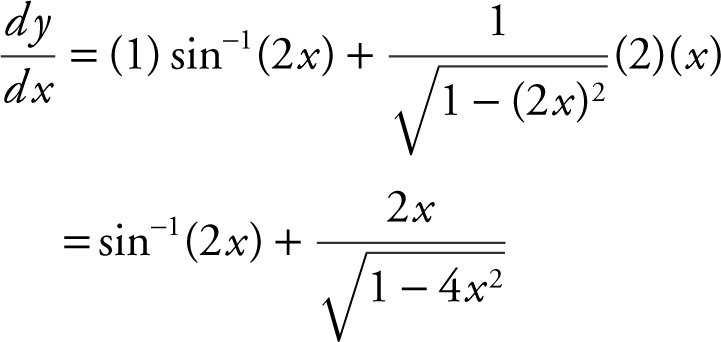
22 . Let y = f (x ) ⇒ y = x 3 – 3x 2 + 3x – 1. To find f –1 (x ), switch x and
y : x = y 3 – 3y 2 + 3y – 1.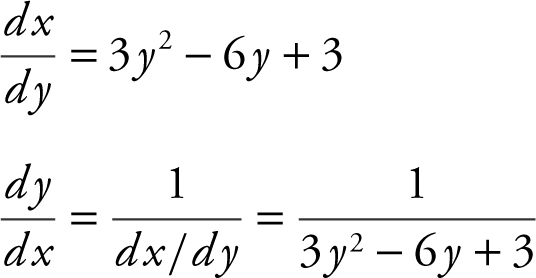

23 . Substituting x = 100 into the expression 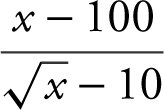 would lead to
would lead to ![]() . Apply L’Hôpital’s Rule, and you have
. Apply L’Hôpital’s Rule, and you have 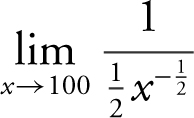 or
or 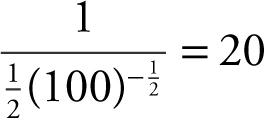 . Another approach to solve the problem is as follows. Multiply both numerator and denominator by the conjugate of the denominator (
. Another approach to solve the problem is as follows. Multiply both numerator and denominator by the conjugate of the denominator (![]() + 10):
+ 10):
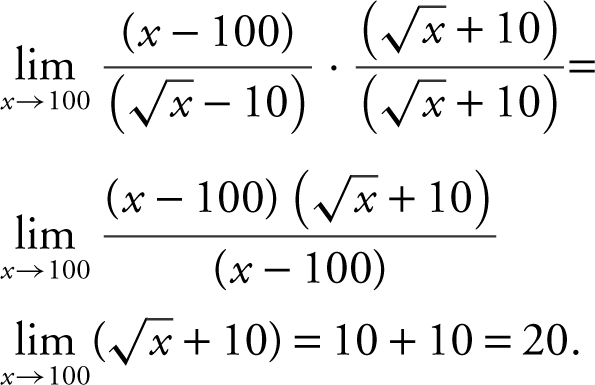
An alternative solution is to factor the numerator:
24 . (a) f ′ > 0 on (–1, 2), f is increasing on (–1, 2), f ′< 0 on (2, 8), f is decreasing on (2, 8).
(b) At x = 2, f ′ = 0 and f ″ < 0, thus at x = 2, f has a relative maximum. Since it is the only relative extremum on the interval, it is an absolute maximum. Since f is a continuous function on a closed interval and at its endpoints f(–1) < 0 and f (8) = 1/2, f has an absolute minimum at x = –1.
(c) At x = 5, f has a change of concavity and f ′ exists at x = 5.
(d) f ″ < 0 on (–1, 5), f is concave downward on (–1, 5).
f ″ > 0 on (5, 8), f is concave upward on (5, 8).
(e) A possible graph of f is given in Figure 10.8-1 .
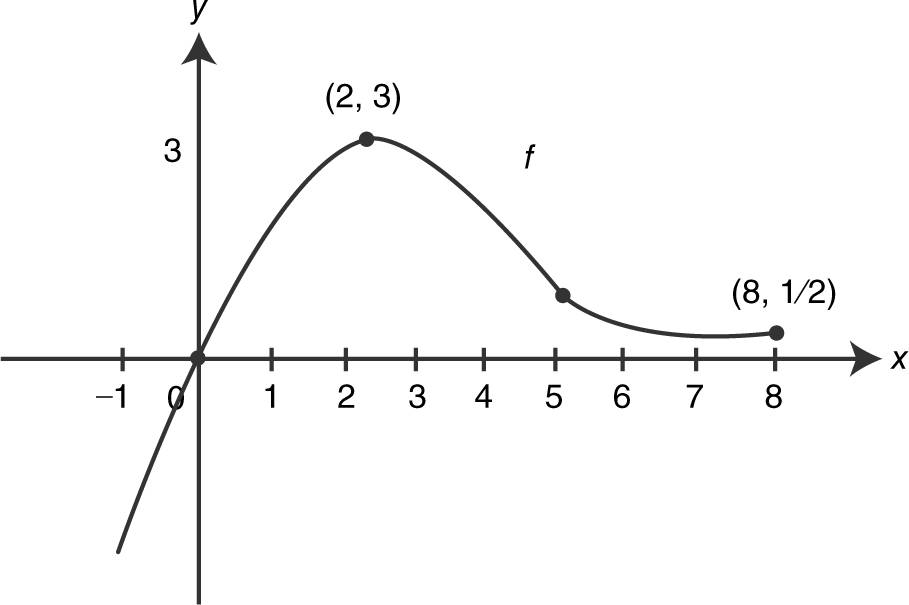
Figure 10.8-1
25 . (a) v (t ) = 3 ft/sec at t = 6. The tangent line to the graph of v (t ) at t = 6 has a slope of approximately m = 1. (The tangent passes through the points (8, 5) and (6, 3); thus m = 1.) Therefore the acceleration is 1 ft/sec2 .
(b) The acceleration is a minimum at t = 0, since the slope of the tangent to the curve of v (t ) is the smallest at t = 0.